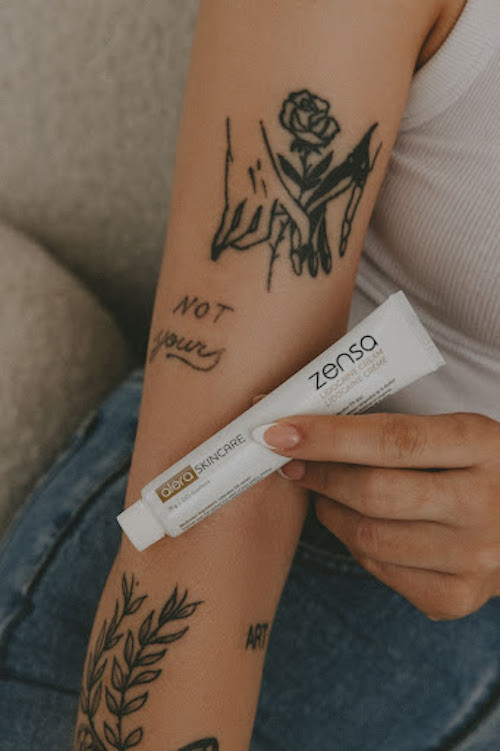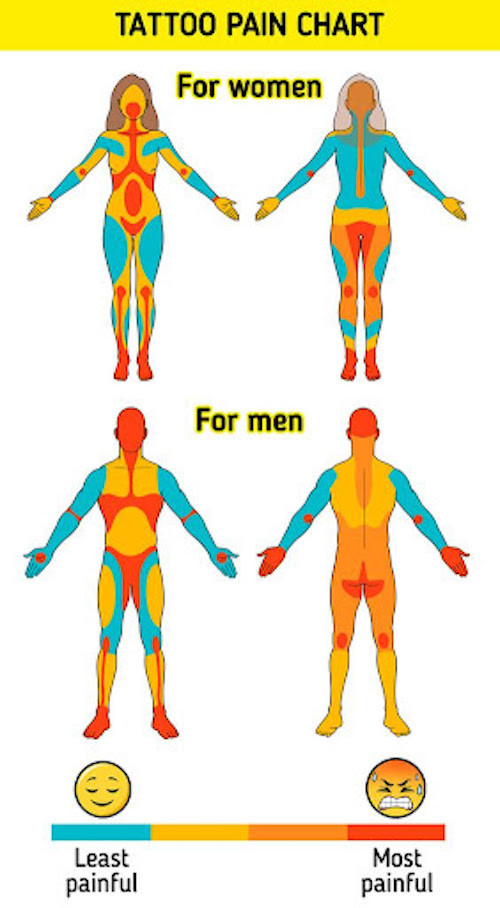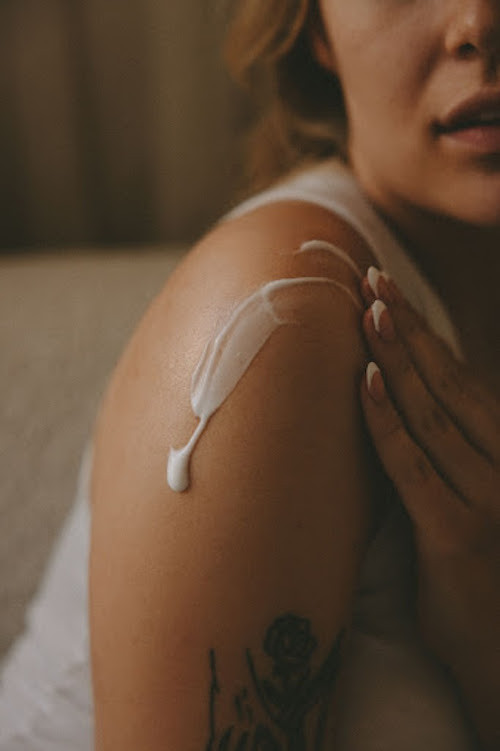Are you pondering getting a shin tattoo but worried about the pain? The intensity of discomfort experienced during a tattoo session is subjective and varies based on several factors, and at tattooat.com, we aim to give you the insights you need, so you can make the right decisions. Understanding these aspects can help you prepare and manage your expectations. Let’s delve into the specifics of shin tattoo pain, exploring pain management techniques and the overall tattooing experience.
1. What Factors Influence Shin Tattoo Pain?
The level of pain you experience with a shin tattoo isn’t set in stone; it’s influenced by several interconnected factors.
- Bone Proximity: The shinbone (tibia) lies just beneath the skin, offering minimal cushioning. This lack of padding means you’ll likely feel more intense vibrations and discomfort as the needle works its magic.
- Nerve Endings: The shin area contains numerous nerve endings, making it highly sensitive. Direct contact from the tattoo needle can trigger significant pain signals.
- Skin Thinness: The skin on your shins is naturally thin compared to other body parts. This thinness intensifies the sensation of the needle penetrating the skin.
- Pain Tolerance: Pain tolerance is highly individual. What one person describes as excruciating, another might find manageable.
- Tattoo Size and Design Complexity: Larger, more intricate designs require longer sessions, which can amplify pain. The duration and intensity of the tattooing process directly impact the overall discomfort experienced.
- Artist’s Expertise: A skilled tattoo artist can make the process more bearable. They use precise techniques and high-quality equipment, minimizing trauma to the skin. Less experienced artists might cause unnecessary pain due to inconsistent pressure or technique.
- Mental State: Stress, anxiety, and fatigue can lower your pain threshold. Arriving relaxed and well-rested can make a significant difference.
- Use of Numbing Agents: Topical numbing creams can reduce pain. However, their effectiveness varies depending on the product and individual response.
2. Is Shin Tattoo Pain Different for Men and Women?
While pain perception is highly personal, there are some gender-related differences that might influence how shin tattoos feel.
| Factor | Men | Women |
|---|---|---|
| Pain Tolerance | Generally, men might report a higher pain tolerance due to cultural and hormonal factors. | Women might have a lower reported pain tolerance, but this is highly variable. |
| Fat and Muscle | Men tend to have more muscle mass on their legs, which can provide a slight buffer. | Women often have slightly more fat on their legs, which could offer minimal cushioning. |
| Hormonal Impact | Hormonal fluctuations can influence pain sensitivity, but this isn’t specific to shin tattoos. | Hormonal fluctuations can influence pain sensitivity, but this isn’t specific to shin tattoos. |
It’s important to remember that these are general trends. Individual experiences can vary widely regardless of gender.
 Shin Tattoo
Shin Tattoo
3. Shin Tattoo Pain vs. Other Body Parts
To put shin tattoo pain into perspective, let’s compare it to other common tattoo locations.
| Body Part | Pain Level (1-10) | Rationale |
|---|---|---|
| Outer Thigh | 3-5 | More muscle and fat provide cushioning. Fewer nerve endings reduce sensitivity. |
| Forearm | 2-4 | Moderate muscle and fat. Relatively few nerve endings. |
| Upper Back | 4-6 | Thicker skin and fewer nerve endings contribute to lower pain levels. |
| Calf | 5-7 | Some muscle and fat, but closer to bone compared to the outer thigh. |
| Rib Cage | 8-9 | Thin skin directly over bone. Numerous nerve endings. Constant movement during breathing intensifies pain. According to Inked Magazine, rib cage tattoos are among the most painful. |
| Spine | 7-9 | Close proximity to bone and spinal nerves. The vibration along the spine can be intense. |
| Ankle/Foot | 8-9 | Thin skin and bone proximity. Many nerve endings make these areas highly sensitive. |
| Shin | 7-9 | Thin skin over bone. Numerous nerve endings. Minimal muscle or fat for cushioning. |
Based on this comparison, shin tattoos are generally considered more painful than areas with more muscle or fat but less painful than locations like the rib cage or spine.
4. How to Prepare for a Shin Tattoo
Proper preparation can significantly reduce discomfort and improve your overall experience.
- Choose an Experienced Artist: Research and select a reputable artist with extensive experience. Read reviews and view their portfolio to ensure they have a steady hand and a good understanding of pain management techniques.
- Stay Hydrated: Drink plenty of water in the days leading up to your appointment. Hydrated skin is more pliable and easier to tattoo.
- Avoid Alcohol and Caffeine: Refrain from alcohol and caffeine for at least 24 hours before your session. These substances can thin your blood, potentially increasing bleeding and pain.
- Get Enough Sleep: Ensure you are well-rested. Fatigue lowers your pain threshold.
- Eat a Meal: Have a substantial meal a few hours before your appointment to maintain stable blood sugar levels.
- Moisturize Your Skin: Keep your skin moisturized in the days leading up to the tattoo. Hydrated skin is easier to work with.
- Wear Comfortable Clothing: Choose loose-fitting clothes that won’t rub against the tattooed area.
- Mental Preparation: Practice relaxation techniques such as deep breathing or meditation to manage anxiety.
- Consider Numbing Creams: Consult with your artist about using a topical numbing cream. Apply it as directed, usually about an hour before the appointment. Zensa Numbing Cream, containing 5% lidocaine, is a popular choice known for its effectiveness.
5. What to Expect During the Tattoo Session
Knowing what to expect can ease anxiety and help you stay calm.
- Consultation: The artist will discuss the design, placement, and any concerns you have.
- Skin Preparation: The artist will clean, shave (if necessary), and sanitize the area.
- Stencil Application: A stencil of the design will be applied to your shin.
- Tattooing: The artist will begin tattooing, starting with the outline and then filling in the design.
- Breaks: Don’t hesitate to ask for breaks if you need them. It’s better to pause than to push through extreme pain.
- Aftercare Instructions: The artist will provide detailed aftercare instructions to ensure proper healing.
6. Pain Management Techniques During Tattooing
There are several strategies you can use during the session to manage pain.
- Deep Breathing: Focus on slow, deep breaths to relax your body and mind.
- Distraction: Bring a book, listen to music, or talk to the artist to take your mind off the pain.
- Squeezing a Stress Ball: This can help redirect your focus and relieve tension.
- Communicate with Your Artist: Let your artist know if you need a break or if the pain is becoming unbearable.
- Use Numbing Products: Reapply numbing cream if needed, following your artist’s advice.
- Stay Still: Try to remain as still as possible to help the artist work efficiently and minimize trauma to the skin.
 Tattoo Pain Chart (Female vs. Male)
Tattoo Pain Chart (Female vs. Male)
7. Aftercare Tips to Minimize Pain and Promote Healing
Proper aftercare is crucial for minimizing pain and preventing complications.
- Keep the Area Clean: Gently wash the tattooed area with mild, fragrance-free soap and warm water.
- Apply a Thin Layer of Aftercare Ointment: Use a recommended aftercare ointment, such as Aquaphor or a specialized tattoo balm.
- Avoid Sun Exposure: Keep the tattoo out of direct sunlight to prevent fading and irritation.
- Wear Loose Clothing: Choose clothing that won’t rub against the tattoo.
- Avoid Soaking the Tattoo: No swimming, baths, or prolonged showers until the tattoo is fully healed.
- Don’t Pick or Scratch: Resist the urge to pick or scratch the tattoo, as this can lead to infection and scarring.
- Stay Hydrated: Continue drinking plenty of water to keep your skin hydrated.
- Follow Artist’s Instructions: Adhere to any specific aftercare instructions provided by your artist.
8. Coping with Shin Tattoo Pain: Psychological Aspects
The mental aspect of pain management is just as important as the physical.
- Positive Mindset: Approach the experience with a positive attitude. Believe that you can handle the pain.
- Visualization: Imagine the final result and focus on the beauty of your tattoo.
- Mindfulness: Stay present in the moment. Acknowledge the pain without judgment and let it pass.
- Support System: Bring a friend for moral support. Having someone there can make the experience less daunting.
- Reward Yourself: Plan a treat for yourself after the session to celebrate your accomplishment.
9. Long-Term Pain and Complications: What to Watch For
While most shin tattoos heal without issues, it’s essential to be aware of potential long-term problems.
- Infection: Signs include redness, swelling, pus, and fever. Seek medical attention immediately if you suspect an infection.
- Allergic Reactions: Some people may be allergic to tattoo ink. Symptoms include itching, rash, and blisters.
- Scarring: Excessive scarring can occur if the tattoo is not properly cared for or if you have a predisposition to keloid formation.
- Nerve Damage: Though rare, nerve damage can cause numbness, tingling, or chronic pain.
- Fading: Tattoos can fade over time due to sun exposure, aging, and skin elasticity. Regular moisturizing and sun protection can help prevent fading.
10. Real-Life Experiences: Shin Tattoo Pain Stories
Hearing from others who have experienced shin tattoos can provide valuable insights.
- Sarah, 28: “I was really nervous about my shin tattoo because I heard it was one of the most painful spots. Honestly, it wasn’t as bad as I expected. The outlining was intense, but the shading was manageable. Deep breathing helped a lot.”
- Mark, 35: “I have tattoos all over my body, and the shin was definitely up there in terms of pain. It felt like a constant vibration on the bone. I used numbing cream, which made a big difference.”
- Emily, 24: “My shin tattoo was my first one, and I almost chickened out. It was painful, but the artist was really good at taking breaks and keeping me distracted. The end result was totally worth it.”
- David, 40: “I’d say the shin is a solid 7 out of 10 on the pain scale. The worst part was the proximity to the bone. I wouldn’t do it again, but I love the tattoo.”
These stories highlight that while shin tattoos can be painful, the experience is manageable with proper preparation and pain management techniques.
 Woman Applying Skincare
Woman Applying Skincare
FAQ: Shin Tattoo Pain
Let’s address some common questions about shin tattoo pain.
-
Are shin tattoos more painful than calf tattoos?
Yes, generally shin tattoos are considered more painful due to the thinner skin and bone proximity compared to the calf, which has more muscle.
-
Does the size of the tattoo affect the pain?
Yes, larger tattoos require longer sessions, which can amplify pain and discomfort.
-
Can numbing cream completely eliminate the pain?
Numbing cream can significantly reduce pain, but it may not eliminate it entirely. Effectiveness varies by individual and product.
-
How long does a shin tattoo take to heal?
Shin tattoos typically take 2-4 weeks to heal, but full healing can take up to 6 months.
-
What should I wear to a shin tattoo appointment?
Wear loose-fitting clothing that won’t rub against the tattooed area.
-
Is it normal for my shin tattoo to be swollen after getting it?
Yes, some swelling is normal. Apply a cold compress to reduce swelling and inflammation.
-
Can I exercise after getting a shin tattoo?
Avoid strenuous activities that could irritate the tattoo. Light walking is okay, but avoid running or leg exercises until the tattoo is fully healed.
-
How do I choose the right tattoo artist for a shin tattoo?
Research artists, read reviews, and view their portfolio to ensure they have experience with shin tattoos and a steady hand.
-
What are the signs of an infected shin tattoo?
Signs include redness, swelling, pus, fever, and increased pain. Seek medical attention immediately if you suspect an infection.
-
Can I use pain medication after getting a shin tattoo?
Over-the-counter pain relievers like ibuprofen or acetaminophen can help manage pain and inflammation. Consult with your doctor if you have any concerns.
Find Your Perfect Shin Tattoo at Tattooat.com
Ready to explore the world of shin tattoos? At tattooat.com, we offer a vast gallery of unique tattoo designs, a curated list of talented tattoo artists, and in-depth articles to guide you through every step of the process.
Discover Stunning Designs
Browse our extensive collection of shin tattoo designs, categorized by style, size, and complexity. Whether you’re looking for a minimalist piece or an intricate masterpiece, you’ll find inspiration at tattooat.com.
Connect with Skilled Artists
Find the perfect artist for your shin tattoo by exploring our directory of vetted professionals. View their portfolios, read reviews, and book a consultation to discuss your vision.
Learn Everything You Need to Know
Access our comprehensive library of articles on tattoo aftercare, pain management, and the latest trends in tattoo art. Equip yourself with the knowledge to make informed decisions and ensure a smooth, enjoyable experience.
Address: 1825 SW Broadway, Portland, OR 97201, United States
Phone: +1 (503) 725-3000
Website: tattooat.com
Visit tattooat.com today and take the first step towards bringing your dream shin tattoo to life.
